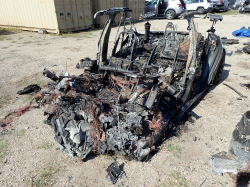
— A Texas Tesla crash did have an occupant in the driver seat when the 2019 Tesla Model S P100D crashed and burned, killing 59-year-old driver Dr. William Varner, and 69-year-old engineer and passenger Everett Talbot.
The latest findings come from an ongoing investigation conducted by the National Transportation Safety Board which determined initial reports of no driver behind the wheel were wrong.
The Texas Tesla crash occurred at about 9:07 p.m. April 17, 2021, in Spring, Harris County, Texas.
According to the NTSB, owner William Varner entered the driver's seat and Everett Talbot entered the passenger seat at the owner's home, as confirmed by a security camera.
The Model S left the house and traveled about 550-feet on a residential road before losing control on a curve, driving over a curb, then slamming into a drainage culvert, raised manhole and a tree.
As seen in the photo above, the fire destroyed the car and the onboard storage device located inside the infotainment console. The restraint control module was recovered but sustained fire damage and was taken to the NTSB recorder laboratory.
The 2019 Tesla Model S was equipped with Autopilot which requires that two features be engaged. Traffic Aware Cruise Control is an adaptive cruise control system that provides acceleration and deceleration. And Autosteer is a lane-keeping system that steers the car in its lane.
The NTSB confirmed Traffic Aware Cruise Control could be engaged but Autosteer was not available on that part of the road.
There were no speed limit signs in the crash area, but Texas officials say the speed limit is 30 mph.
Initial police reports said the Tesla driver was found in the back seat, leading to statements that suggested the driver wasn't in the driver's seat when the crash occurred.
Based on results from the NTSB investigation, the driver was in the driver's seat when the crash occurred, but results from the Harris County Institute of Forensic Sciences also found Varner's blood alcohol level was nearly double the legal limit of 0.08%.
An autopsy showed Varner died from "blunt force trauma and thermal injuries with smoke inhalation."
Tesla Model S Steering Wheel Damage / Event Data Recorder
As part of the investigation into whether the Tesla Model S had an occupant in the driver's seat, the NTSB analyzed the steering wheel and how it was deformed in the crash. In addition, the damaged event data recorder was repaired which allowed the NTSB to extract important crash data.
The NTSB found part of the steering wheel was damaged by heat from the fire, but another section was deformed from an impact to the steering wheel.
Data from the recorder shows both Tesla Model S front seats were occupied and the seat belts were buckled at the time of the crash. NTSB investigators also determined the driver was applying the accelerator pedal as high as 98.8% and the highest speed in the five seconds leading up to the crash was 67 mph.
The Texas Tesla crash investigation isn't complete as investigators continue to study the event data recorder and compare it with evidence from the crash scene.
CarComplaints.com will update our website when the government releases additional details.




